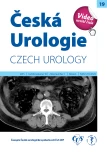URINE TUMOUR ASSOCIATED TRYPSIN INHIBITOR (TATI) IN DIAGNOSIS AND PROGNOSIS OF TRANSITIONAL CELL CARCINOMA OF THE BLADDER
Authors:
Michael Pešl 1; Viktor Soukup 1; Marko Babjuk 3; Otakar Čapoun 1; Zuzana Vaľová 1; Pavel Dundr 2; Tomáš Hanuš 1
Authors‘ workplace:
Urologická klinika VFN a 1. LF UK, Praha
1; Urologická klinika FNM a 2. LF UK, Praha
2; Patologický ústav VFN a 1. LF UK, Praha
3
Published in:
Ces Urol 2015; 19(1): 44-50
Category:
Original Articles
Overview
Aim:
The aim of this study was to assess the utility of TATI level in urine as a non-invasive method for detecting urinary bladder cancer and evaluating its prognosis.
Materials and Methods:
Sixty three patients were enrolled in the study (38 men, 25 women), with a mean age of 66.2 years, and an average follow-up time of 23 months. Patients were divided into groups according to tumour grade, stage, number of lesions, and their size. Thirty three patients with benign urological disease were included as controls.
Results:
The median TATI level in the group patients with tumours was 68.65 μg/l. In the control group it was 20.38 μg/l. The mean TATI level was 15.76 μg/l in the G1 group, 86.3 μg/l in G2 group, and 33.3 μg/l in G3 group. The mean TATI level in patients with a TaT1 tumour was 73.3 μg/l, and 40.51 μg/l in patients with an invasive carcinoma. The TATI level in solitary tumours was 60.28 μg/l, 94.42 μg/l in multiple tumours, 26.3 μg/l in tumours up to 3 cm, and 100.02 μg/l in larger tumours. The mean TATI level in the group of patients with bladder tumour recurrence during follow-up was 60.3 μg/l, 75.0 μg/l without recurrence, 12.0 μg/l in patients who progressed, and 55.7 μg/l in patients who did not progress.
Conclusions:
Our results demonstrate that the level of TATI in the urine does not correlate with the risk of bladder tumour, tumour size, multiplicity or the grade, and recurrence free survival.
KEY WORDS:
bladder tumours, non-invasive diagnosis, recurrence, progression, TATI (tumour-associated trypsin inhibitor)
Sources
1. Ferlay JSH, Bray F, Forman D, et al. GLOBOCAN 2008 v1.2, Cancer Incidence and Mortality Worldwide: IARC CancerBase No. 10 2010, International Agency for Research on Cancer: Lyon, France.
2. Sylvester RJ, van der Meijden APM, Oosterlinck W, et al. Predicting recurrence and progression in individual patients with stage TaT1 bladder cancer using EORTC risk tables: a combined analysis of 2596 patients from seven EORTC trials. Eur Urol 2006; 49: 466–477.
3. Venesmaa P, Lehtovirta P, Stenman UH, et al. Tumour-associated trypsin inhibitor (TATI): comparison with CA 125 as a preoperative prognostic indicator in advanced ovarian cancer. Br J Cancer 1994: 70: 1188.
4. Meria P, Toubert ME, Cussenot O, et al. Tumour-associated trypsin inhibitor and renal cell carcinoma. Eur Urol 1995: 27: 223.
5. Taccone W, Mazzon W, Belli M. Evaluation of TATI and other markers in solid tumors. Scand J Clin Lab Invest Suppl 1991: 207: 25.
6. Kelloniemi E, Rintala E, Finne P, Stenman UH. Tumour-associated trypsin inhibitor as a prognostic factor during follow-up of bladder cncer. Urology 2003: 62: 249.
7. Patschan O, Shariat SF, Chade DC, et al. Association of tumor-associated trypsin inhibitor (TATI) expression with molecular markers, pathologic features and clinical outcomes of urothelial carcinoma of the urinary bladder. World J Urol. 2012 Dec; 30(6): 785–794.
8. Pectasides D, Bafaloucos D, Antoniou F, et al. TPA, TATI, CEA, AFP, beta-HCG, PSA, SCC, end CA 19-9 for monitoring transitional cell carcinoma of the bladder. Am J Clin Oncol 1996: 19: 271.
9. Diggle CP, Cruickshank S, Olsburgh JD, et al. Identification of gene sup-regulated in urothelial tumors: the 67-kd laminin receptor and tumor-associated trypsin inhibitor. Am J Pathol 2003: 163: 493.
10. Gkialas I, Papadopoulos G, Iordanidou L, et al. Evaluation of urine tumor-associated trypsin inhibitor, CYFRA 21-1, and urinary bladder cancer antigen for detection of high-grade bladder carcinoma. Urology. 2008; 72(5): 1159–1163.
Labels
Paediatric urologist Nephrology UrologyArticle was published in
Czech Urology

2015 Issue 1
Most read in this issue
- IMMUNOSTIMULATION WITH POLYBACTERIAL LYSATE (URIVAC®) IN PREVENTING RECURRENT LOWER URINARY TRACT INFECTIONS
- COMPLICATIONS FOLLOWING LOCAL APPLICATION OF INORGANIC MATERIAL INTO THE SUBCUTANEOUS TISSUE OF PENIS
- ONCOLOGICAL TREATMENT OF PENILE CANCER FROM THE POINT OF VIEW OF RADIATION ONCOLOGIST
- EMPHYSEMATOUS PYELONEPHRITIS – DESCRIPTION OF SIX CASES
